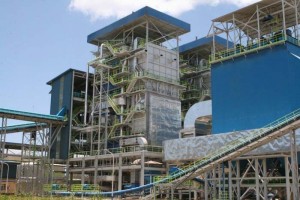Jagdeo defends US$200M Skeldon sugar factory
-despite massive losses, debts over the years
Despite its massive losses and the debts it has amassed over the years, the US$200M investment into the Skeldon sugar factory and (by extension) the expansion project is justified and was not, after all, a ‘white elephant’.
This is according to Leader of the Opposition, Bharrat Jagdeo, during a press conference at his party’s headquarters.
Citing the fact that the Skeldon factory has recently seen its best production figures since it was commissioned in 2009, the former President was adamant the factory turn around justifies that it was not a ‘white elephant.’
The US$200M Skeldon modernization project had encompassed a new factory and expanding cane lands. The project was one of Guyana’s largest ever initiatives but came at a time when countries in the region, like Belize, Barbados, St Kitts and Trinidad and Tobago, had abandoned sugar.
This is because sugar in the region had been on a downward slump for years. In Guyana, the sugar industry has had to deal with attrition (large amounts of workers leaving the industry), high production costs and the loss of the decades old preferential prices offered by the European Union to Guyana.
The agreement had allowed Guyana and other regional countries to sell sugar at preferential prices. However, the phased price cuts by the EU amounted to 36 percent drop in prices and some $7B in losses for Guyana, annually.
However, the then People’s Progressive Party (PPP) government had insisted that sugar was viable for the country and had proceeded with the US$200M Skeldon modernization project.
But the Skeldon factory turned out to be the worst performing sugar estate in Guyana, its production even lower than the older, less modern factories. While the older factories used some 12 tonnes of cane to produce one tonne of sugar, Skeldon used 17 tonnes to procude one tone sugar.
Over the years there have been several glitches and attempts to fix them, including the punt dumper. Statistics show the factory has been the worst performing and the most inefficient in terms of the amount of cane it took to produce sugar.
Jagdeo acknowledged that Skeldon’s infamous production figures of 17 tonnes of cane to one tonne of sugar was because of physical problems with the factory. He noted that the factory is now processing 11 or less tonnes to get one tonne of sugar.
“It shows that the factory is working,” Jagdeo said. “It is not a white elephant. At 11 (tonnes) that’s great. The recent increase in production (is because of) some of the changes made to the factory like the punt dumper (which takes the cane from the waterways to the factory).”
“Plus we had better weather, so you did have more cane going through the factory. And I don’t want to knock any production increase because I am happy. But white elephant project number one, under Jagdeo, is justified.”
Over the years, the Chinese-built factory has not only been leaking money, but had also amassed massive debts. Debts in excess of billions of dollars have been owed to the Guyana Revenue Authority (GRA), the National Insurance Scheme (NIS) and to regional and international banks and funding agencies.
It was pointed out to the former President the costs incurred by the Skeldon factory over the years, but Jagdeo took the position that the issue could not be seen in a “dollar and cents” way. He also expressed optimism that over time the factory could recoup the money it’s lost.
“When you look at an industry that is probably 15 percent of your gross domestic product and hires, (both) directly and indirectly over 100,000 people,” Jagdeo stated. “An industry that predominates in an entire region (six), it would have a disproportionate impact in terms of disposable income.”
Jagdeo was adamant that sectors have to be assessed in that context. He referenced the United States decision to inject 100’s of billions of dollars in cash in the private financial sector (during the global financial crisis) as a decision taken to stabilize the economy.


